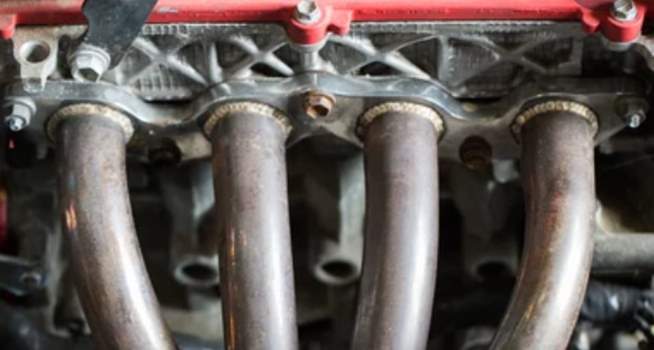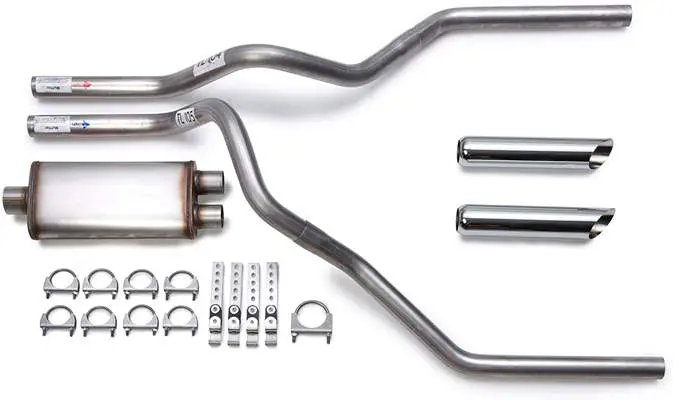
Picture this: You start your car in the morning but are startled to hear a sound as loud as a NASCAR racer. It means there are some weird symptoms all pointing towards an exhaust manifold leak.
Exhaust manifold leaks range from some minor problems to major issues. In this article, I have provided some really helpful information on exhaust manifold leaks for you people.
What are the Exhaust Manifold Leak Symptoms?
It is important to know the symptoms of exhaust manifold leaks before describing how to fix them and other necessary information.
- You will hear weird sounds
- You will hear a ticking sound louder than normal while the car is running
- The entire power band will lose power
- The exhaust will be smelly and noisy
- Loud ticking under the hood during acceleration when the engine is cold
- When you are driving along, and if you step on the gas and the RPM jump above 3000, you hear a sound coming from under the car that sounds like “flapping” as the vehicle speed and RPM increase, the noise gets louder. Once the car shifts and the RPMs drop, the sound magically goes away.
- Loud exhaust leak sounds when the car is cold
Exhaust Manifold Leak Sound – What it Sounds Like?
The best way of identifying an exhaust manifold leak is to know how it sounds. Usually, the exhaust manifold leak sounds like air pressure coming out from the manifold area. Apart from this, there are other sounds of exhaust manifold leak as well which are following:
- A distinctive “tick, tick, tick” or “click, click, click” sound
- Whistling, pooty, and rattle sounds
- A fast ticking sound if the leak is close to the engine
- If going down the line then the sound is more like hissing
How to Find Exhaust Manifold Leak?
Before going to fix the way, the first step should be to find out where the exhaust manifold leak is. Numerous ways can help you find the exhaust manifold leak, and some of these are as follows:
- Finding leak by turning VAC on
- Finding a leak by using soapy water
- Finding leak by covering tailpipes with hand
- Look for black spot in the surrounding because when there is a leak, it will cause the surrounding area to turn black
1. Finding Leak by Turning VAC ON
The first way of finding the leak is to turn on the VAC, and for that, you will have to follow the steps provided below:
- Figure out the tailpipe situation and if there are dual tailpipes, then block one of them
- Take a vacuum and attach it to the tailpipe
- Turn on the vacuum to let the air start flowing
- Move on to the underside of the car
- As you move on to the underside of the car, you will be able to hear the sound of air escaping
- Follow the sound of the air to identify the location of the leak
2. Finding a leak by using soapy water:
If you cannot identify the leak using the above method, then another way is to use soapy water. For this, you will have to spray the soapy water on the tailpipes. If the exhaust is leaking, you will see bubbles forming on the tailpipes.
3. Finding Leak by Covering Tailpipes with Hand
Sometimes there are cases in which we are unable to hear the exhaust leaks. In such circumstances, you will have to get the help of your friend and follow the given steps:
- Have your friend press the rags over the ends to block both the tailpipes
- Allow the back pressure to build-up
- Remember not to block the exhaust completely
- Listen along the entire length of the exhaust by getting as close to it as you can
- Using your ears, identify the leaks (smaller leaks have hissing sound)
- Use your hands to feel the leaks but don’t touch the exhaust; instead, put your hand near the exhaust
- Remember that there is minimum in the surrounding, as it will help you to hear the sound of the leaks and verify it easily
How to Fix an Exhaust Manifold Leak?
Here we are at the most important part of our discussion, i.e., ways of fixing leaks. Fixing leaks depend on where they are located. Following are some of the ways to fix the exhaust manifold leaks.
How to Temporarily/Quick Fix Exhaust Manifold Leak?
The below content has three types of fixes for exhaust manifold leak on flange:
- If there is a small gap and you are getting a serious exhaust leak, the best option for you is to use some gel or putty that is good for exhaust temperatures. Put a bead of it on the crack, and smash it together like a sandwich. After you are done, you can scrape it off. After applying a nice coat of the gel or putty, push it together to seal the gap or crack.
- If the weld holding the pipe to the flange cracks. As the weld cracks, the pipe will start moving relative to the flange, and it would become easy to remove it from the truck. Now what you will have to do is to re-weld the flange so that it lasts longer.
- Another way of fixing the exhaust on the flange is to flatten the old flange and use a c shape bracket.
Leaking Exhaust Between the Manifold and the Head
If the exhaust leak is present between the manifold and the head, you have to drill out the broken bolts and insert the new ones. If you are fixing it all by yourself, then be careful because there are chances that you may damage the head.
What sometimes happens too is that the exhaust manifolds aren’t 100% straight. This can cause leaking too.
How to Fix an Exhaust Manifold Gasket Leak?
- Remove the bolts connecting y exhaust pipe and the cat pipe
- Remove the left front tire and splash guard
- Disconnect the sensor wiring connectors
- Remove the top bolts that connect the cat to the exhaust header
- Lift the cat out of the bottom bracket and align it in such a way that you remove the bottom bolts that hold the cat bracket
- Remove bottom bolts and bracket, and metal gasket will come out with it
- And with the bracket removed along with the gasket, you can see/feel the exhaust leak
- Clean up the exhaust manifold, replace the gasket if it is cracked or if it doesn’t need replacing, seal (sealing ways are given in below headings) it up. Button and torque everything back up.
- Turn the vac back on and check for bubbles. If there are no bubbles, check if there is a crack in the manifold that can be fixed by welding it.
How to Fix an Exhaust Leak Without Welding?
If you are looking for some inexpensive ways to fix the exhaust leaks without welding, then you can use the following ways:
- One way of fixing the leaks without welding is to use exhaust putties, a clay like thing that you have to push into the crack or the leak, and as it hardens, it feels like steel.
- Another thing you can try using is a muffler bandage. It is similar to an ace bandage. You have to wrap it around the muffler, and as it seals, it becomes hard.
- Last but not least, you can also use an exhaust band clamp. You will have to get it over the damaged area, and as you tighten it down, it will seal the crack or leak.
How Hard is It to Fix an Exhaust Manifold Leak?
I have heard many people questioning whether it is an easy task to repair an exhaust manifold leak or not.
Well, after determining the leak it’s really not that hard to fix the exhaust manifold leak, although mending the rupture on the driver side is time-consuming because of removal and reinstallation of the stuff in the way such as the steering box.
How Long Does it Take to Fix an Exhaust Manifold Leak?
As you are now aware of how to fix the leaks, you may be thinking about how long to fix the exhaust manifold leak.
The major part of the answer will be based on how easy that area is to access AND whether any bolts break off and need to be drilled, tapped, and removed. Replacements take from as little as 2 hours to as much as 10 hours.
Similarly, the time taken to replace the manifold gasket is around 30 minutes to 2 hours, but it all depends on the condition of the studs.
What is the Exhaust Manifold Leak Repair Cost?
One important thing that you should consider is the cost of repairing an exhaust manifold leak. The cost lies in how easy that area is to access and whether any bolts break off and need to be drilled, tapped, and removed.
If you go to a shop for repairing, it will prove costly because original systems will be welded together and maybe more than one piece will be replaced. Also, it would be dependent on the type of leak and the location of the leak.
For example, if the leak is in the joints of the exhaust system, then fixing it is easy. Still, if it is with the manifold and the engine, it would require the removal of manifold and use of new gaskets or even the manifold if there is a crack in the cast iron, and it would take almost 2 hours to fix it.
For your ease, I have provided a part-wise distribution of the cost of repairing an exhaust manifold leak:
| PortSide | $350 |
| Starboard | $344 |
| All Gaskets (2+4+4) | $26 |
| Elbow | $237 |
| Elbow | $237 |
| Total Parts | $1,194 |
To put it simply, repairing an exhaust manifold leak is expensive, but still, some inexpensive DIY methods can help you fix the leak.
Conclusion
As we wrap up our discussion, I would like to tell you that a car’s exhaust system is necessary to clean and move the toxic gases out of the vehicle. This means it is important to fix a leak in the exhaust manifold because if you don’t, the toxic gases will reverse their flow and go back into the car.
Related Article: Is Driving With a Bad Catalytic Converter Safe



